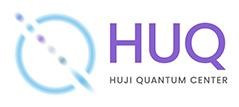
The Quantum Center
Special Symposium
Quantum Sensing and Computing
Speaker #1 (12:00):
Prof. Alexander Huck
Department of Physics - Technical University of Denmark
Title:
"Quantum sensing of bio-magnetic fields using defect centres in diamond"
Abstract:
The negatively charged nitrogen-vacancy (NV−) center in diamond has excellent spin properties with a long lifetime and coherence. In combination with the robustness of diamond, this set of properties enables a broad range of innovative applications, including nano-meter scale nuclear magnetic resonance, sensing of radical-pair reactions, or recording the magnetic field component induced by ionic charge in living biological tissue.
In this talk, I will address two advances recently made in our group. I will report on (a) our experiments using NV centers to recover bio-magnetic signals from living tissue in vitro and (b) our recent efforts on controlling and utilizing the NV charge state for nanometer scale sensing tasks in the vicinity of the diamond surface.
(a) Using electrical and optogenetic stimulation, we are able to trigger and record compound action potentials from muscle tissue [1] and from the brain (corpus callosum) of mice, with high stability over the course of many hours. I will show that our diamond sensor can recover these signals in an ordinary laboratory environment, without the need for extensive shielding against background magnetic noise.
(b) From the detailed characterization of more than 30 single NV centers implanted ~5nm below the diamond surface, we observe a strong variability in the initialization probability into the negative charge state NV−. After coating the diamond with deuterated glycerol, we observe a consistent increase of charge initialization in NV- and a reduction of the ionization rate from NV− to the neutral charge state NV0. These observations indicate the role and importance of the local and near-surface charge environment for the stability of the NV charge state. Finally, I will address our efforts on mapping the NV- spin state to the NV charge state, and illustrate that in the context of a nanometer scale sensing task this approach has strong potential for improving the readout noise figure as compared to the conventional readout via fluorescence detection.
[1] Webb et al., Scientific Reports 11, 2412 (2021), doi: 10.1038/s41598-021-81828-x
Speaker #2 (13:30):
Dr. Michael Stern
Department of Physics - Bar-Ilan University
Title:
"Reproducibility and control of superconducting flux qubits"
T. Chang, I. Holzman, T. Cohen, B. C. Johnson, D. N. Jamieson and M. Stern
Abstract:
Superconducting flux qubits are good candidates for the physical realization of a scalable quantum processor. Indeed, these circuits may have both a small decoherence rate and a large anharmonicity. These properties enable the application of fast quantum gates with high fidelity and significantly reduce the limits to scaling.
The major difficulty of flux qubits' design consists of controlling precisely their transition energy - the so-called qubit gap- while keeping long and reproducible relaxation times. Solving this problem requires an extremely good control of e-beam lithography, oxidation parameters of the junctions and sample surface and has not been solved so far.
Here we present measurements of a large batch of flux qubits and demonstrate an unprecedented level of control of qubit gaps and relaxation times. This reproducibility enabled us to analyse the different factors that influence the coherence of the qubits and opens the way for potential applications in the fields of quantum hybrid circuits and quantum computation.

